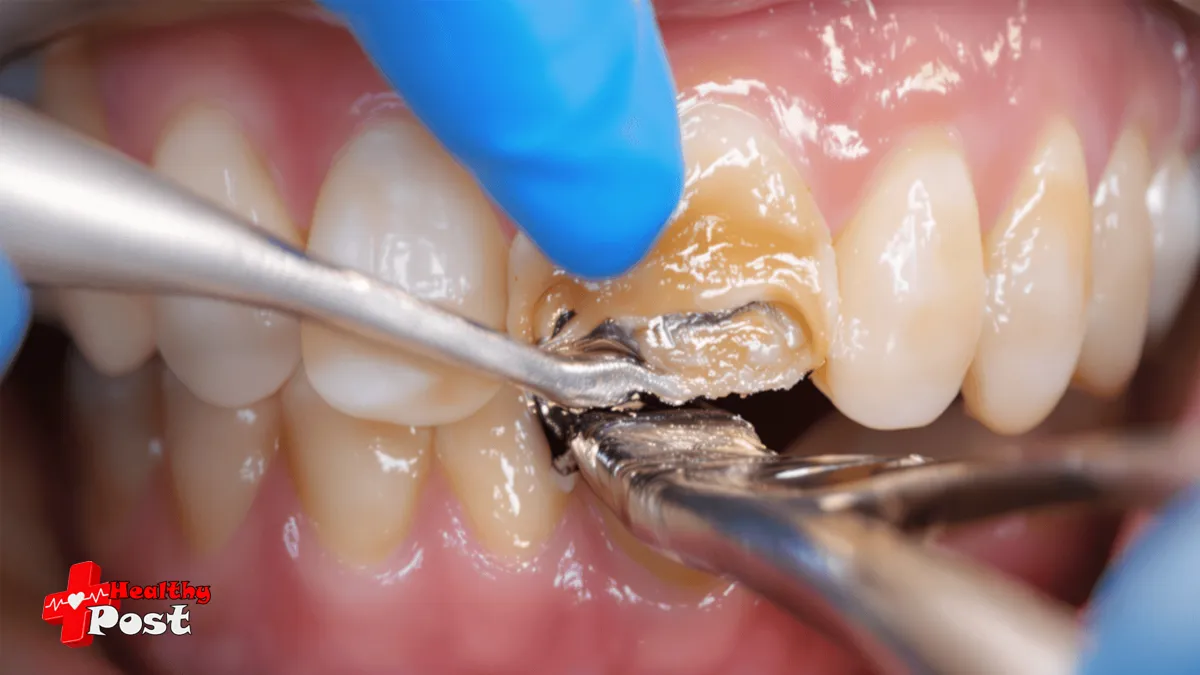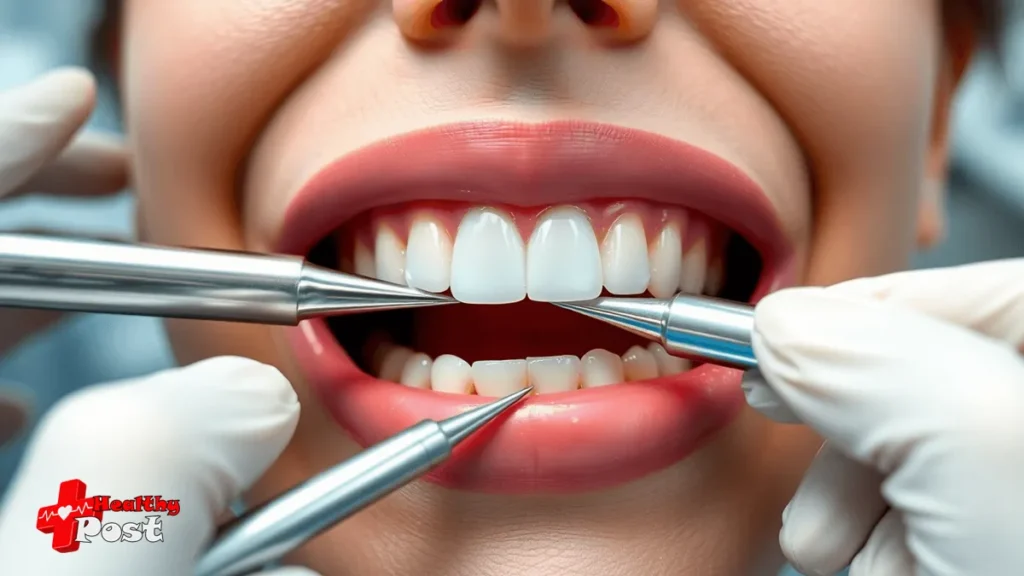
5 Powerful Ways to Remove a Calculus Bridge and Restore Your Dental Health
A calculus bridge forms when dental plaque hardens into tartar, creating a solid connection between multiple teeth. This stubborn dental issue affects millions of people worldwide, causing serious problems for their dental health.
Think of a calculus bridge as a harmful wall of hardened deposits that:
- Traps harmful bacteria against your teeth
- Irritates your gums
- Leads to bad breath
- Can cause tooth decay
- May result in gum disease
The presence of this dental buildup signals a need for immediate professional attention. Regular brushing and flossing alone can’t remove these tough deposits once they’ve formed.
In this article, we’ll explore 5 proven methods to remove calculus bridges and help you regain a healthy smile. These techniques range from professional cleaning procedures to surgical interventions for severe cases. You’ll learn which approach might work best for your situation.
Understanding Calculus Bridges
A calculus bridge starts as a soft, sticky film of dental plaque on your teeth. When left untreated, this plaque mixes with minerals in your saliva and hardens into tartar.
The appearance of calculus bridges varies based on their location:
- Above the gumline: Yellow or tan-colored deposits that form a bridge between teeth
- Below the gumline: Dark brown or black buildups that can hide serious damage
Several factors increase your risk of developing calculus bridges:
- Poor Oral Hygiene
- Irregular brushing habits
- Skipping daily flossing
- Not using antimicrobial mouthwash
- Dietary Choices
- High sugar consumption
- Frequent starchy foods
- Acidic beverages
- Lifestyle Factors
- Smoking or vaping
- Dry mouth conditions
- Certain medications
The hardening process of plaque happens quickly – it can transform into tartar within 24-72 hours. This rapid transformation makes daily oral care essential for preventing calculus bridge formation.
Your saliva plays a key role in this process. The minerals in saliva combine with plaque deposits, creating hard, cement-like structures that bond to your teeth’s surface.
Health Risks Associated with Calculus Bridges

A calculus bridge creates the perfect hiding spot for harmful bacteria in your mouth. These bacteria release toxins that irritate your gums, making them red and swollen.
The presence of trapped bacteria leads to several dental complications:
- Gum Disease Progression: Untreated gum disease can progress from gingivitis (tender, bleeding gums) to periodontitis (damaged bone and tissue), potentially resulting in tooth loss.
- Bad Breath (Halitosis): Bacteria produce sulfur compounds, leading to persistent unpleasant mouth odor that can impact social and professional interactions.
- Dental Structure Damage: Calculus bridges can weaken tooth enamel, cause decay on the root surface, loosen teeth, and result in gum recession.
The impact of calculus bridges extends beyond your mouth. Research links poor oral health to serious health conditions:
- Heart disease
- Diabetes complications
- Respiratory infections
- Pregnancy complications
Your immune system works harder to fight the constant bacterial presence caused by calculus bridges. This ongoing battle can weaken your body’s natural defenses against other illnesses.
Regular dental check-ups are crucial in catching these issues early. During these visits, a professional cleaning can remove calculus bridges before they cause lasting damage to your oral health.
1. Professional Scaling
Professional scaling is one of the main methods we recommend in our article 5 Powerful Ways to Remove a Calculus Bridge and Restore Your Dental Health. This dental procedure uses specialized tools to remove hardened tartar deposits.
What Happens During a Dental Scaling Procedure?
A dental scaling procedure involves:
- Hand Scalers: Special curved instruments that scrape away calculus
- Dental Curettes: Tools designed to reach under the gumline
- Periodontal Probes: Measuring devices to check pocket depths
During your scaling session, the dentist or hygienist will:
- Check your teeth and gums for calculus deposits
- Use water sprays to keep the area clean
- Remove tartar buildup section by section
- Polish teeth surfaces after scaling
The procedure takes 30-60 minutes based on calculus amount. You might feel mild pressure or scraping sensations. Local anesthesia helps if you have sensitive gums.
How Does Professional Scaling Benefit You?
Professional scaling removes up to 2mm of tartar below the gumline. This deep cleaning reaches areas regular brushing can’t touch.
Your dentist will:
- Clean both visible and hidden calculus
- Remove stains from teeth surfaces
- Check for signs of gum disease
- Give specific care instructions
After scaling, your teeth feel smoother. Your gums might feel tender for 1-2 days. Regular brushing and flossing help prevent new calculus formation.
2. Ultrasonic Scaling
Ultrasonic scaling brings modern technology to dental cleaning through specialized devices that create rapid vibrations. These tools work at frequencies between 25,000 to 42,000 Hz to break down stubborn tartar deposits.
How does it work?
The ultrasonic scaler consists of three main parts:
- A hand-held wand with a metal tip
- A water cooling system
- A power control unit
The vibration technology creates tiny bubbles in the cooling water, which burst against the teeth. This process, called cavitation, helps:
- Break up tartar deposits
- Kill harmful bacteria
- Flush away debris
Benefits of ultrasonic scaling:
- Less pressure needed compared to manual tools
- Reduced treatment time
- Better access to deep pockets
- Enhanced comfort for patients
- Minimal damage to tooth enamel
Special considerations
Some patients might need special consideration before ultrasonic scaling:
- People with pacemakers
- Those with sensitive teeth
- Patients with respiratory conditions
Power adjustments
Your dentist will adjust the power settings based on:
- Tartar thickness
- Tooth sensitivity
- Gum condition
- Patient comfort level
The treatment typically takes 30-45 minutes, with most patients reporting minimal discomfort. A cooling mist keeps the area comfortable during the procedure.
3. Root Planing for Deep Cleaning
Root planing reaches deep below your gumline to remove stubborn calculus deposits. This specialized cleaning method smooths rough spots on tooth roots where bacteria love to hide.
What Makes Root Planing Different?
- Targets calculus hidden under your gums
- Smooths damaged root surfaces
- Removes infected tooth structure
- Helps gums reattach to teeth
The procedure uses special tools to access deep pockets between your teeth and gums. Your dentist will numb the area to keep you comfortable during the treatment.
Benefits of Root Planing:
- Reduces gum inflammation
- Shrinks deep pockets
- Stops bone loss
- Prevents tooth loss
- Promotes gum healing
Your dentist might recommend root planing when:
- Gum pockets measure deeper than 4 millimeters
- X-rays show bone loss
- Gums bleed easily
- Previous treatments haven’t worked
- Severe gum inflammation exists
The healing process starts right after treatment. Your gums will begin to tighten around your teeth within days. Full recovery typically takes 2-4 weeks with proper care.
Most patients need root planing when regular cleanings can’t reach deep calculus deposits. This treatment works best combined with good home care habits.
4. Use of Antibiotics and Antimicrobial Agents
Antibiotics are crucial in treating bacterial infections associated with calculus bridges. Your dentist may include them in your 5 Powerful Ways to Remove a Calculus Bridge and Restore Your Dental Health treatment plan.
Common antibiotic forms include:
- Oral tablets or capsules
- Antimicrobial mouth rinses
- Topical gels applied directly to gums
- Time-release strips placed in gum pockets
Dentists commonly prescribe antibiotics such as doxycycline or amoxicillin to eliminate harmful bacteria. These medications are most effective when used alongside professional cleaning techniques.
Antimicrobial treatments come in different forms:
- Chlorhexidine rinses reduce bacteria and prevent plaque buildup
- Antiseptic gels target specific problem areas
- Medicated toothpaste helps prevent new bacterial growth
Your dentist will develop a personalized treatment plan tailored to your specific needs. They may combine various antibiotics to achieve optimal results.
Remember: Antibiotics alone cannot eliminate calculus bridges. Their purpose is to assist in:
- Controlling gum infection
- Reducing inflammation
- Accelerating healing
- Preventing the recurrence of bacteria
Always complete the entire course of antibiotics prescribed, even if your symptoms improve. This practice helps prevent antibiotic resistance and ensures the most effective treatment outcome.
5. Surgical Intervention for Severe Cases
When deep gum pockets exceed 5 millimeters, periodontal surgery becomes essential. These pockets create hidden spaces where bacteria thrive beyond the reach of regular cleaning methods.
Dental professionals use different surgical approaches:
- Flap Surgery: The dentist lifts the gums to clean deep tartar deposits
- Bone Grafting: Rebuilds damaged bone tissue caused by severe calculus buildup
- Soft Tissue Grafts: Repairs receded gums from long-term calculus damage
The surgical process takes 1-2 hours under local anesthesia. Your dentist might use laser technology to reduce bleeding and speed up healing.
Recovery Timeline:
- Days 1-3: Rest and soft foods only
- Week 1: Gentle brushing around surgical area
- Weeks 2-4: Gradual return to normal oral care
- Month 2: Full healing expected
Post-Surgery Care Tips:
- Take prescribed pain medication
- Use ice packs to reduce swelling
- Avoid smoking or alcohol
- Follow a soft food diet
- Rinse with salt water 3-4 times daily
Most patients return to work within 2-3 days after deep gum pockets treatment. Success rates reach 85% when patients maintain good oral hygiene after surgical tartar removal.
Preventive Measures to Avoid Calculus Bridges
A strong oral hygiene routine is your first defense against calculus bridges. Here’s how to build effective daily habits:
Essential Daily Practices:
- Brush your teeth twice daily for 2 minutes
- Use a soft-bristled toothbrush at a 45-degree angle
- Apply gentle circular motions near the gumline
- Choose fluoride toothpaste for added protection
- Clean between teeth with dental floss or interdental brushes
Smart Prevention Tips:
- Replace your toothbrush every 3-4 months
- Use an electric toothbrush with pressure sensors
- Clean your tongue daily to reduce bacteria
- Rinse with water after meals when brushing isn’t possible
Antiseptic mouthwash plays a key role in preventing tartar buildup. Add it to your routine:
Mouthwash Benefits:
- Kills harmful bacteria in hard-to-reach areas
- Reduces plaque formation between brushing
- Strengthens tooth enamel when fluoride-based
- Freshens breath while fighting bacteria
Pro Tip: Time your mouthwash use 30 minutes after brushing to maximize fluoride contact with teeth.
A balanced diet supports these preventive measures:
- Limit sugary snacks and drinks
- Choose crunchy fruits and vegetables
- Drink plenty of water throughout the day
- Avoid sticky foods that cling to teeth
Lifestyle Changes That Support Oral Health Maintenance
Small changes in your daily habits can make a big difference in preventing calculus bridges. Here’s what you can do:
Stay Hydrated for Better Oral Health
- Drink 8 glasses of water daily
- Water helps wash away food particles
- Saliva production increases with good hydration
- Natural protection against harmful bacteria
Quit Smoking for Healthier Teeth
- Smoking reduces blood flow to gums
- Tobacco use weakens your immune system
- Smoking speeds up tartar formation
- Yellow teeth stains develop faster
Smart Food Choices
- Choose crunchy fruits and vegetables
- Eat calcium-rich foods for stronger teeth
- Limit sugary snacks and drinks
- Pick sugar-free gum between meals
Sleep Position Matters
- Sleep with your head elevated
- This reduces nighttime acid reflux
- Less acid means less tooth damage
- Better saliva flow during sleep
Stress Management
- High stress leads to teeth grinding
- Practice relaxation techniques
- Consider using a night guard
- Regular exercise helps reduce stress
These lifestyle adjustments complement the 5 Powerful Ways to Remove a Calculus Bridge and Restore Your Dental Health. Simple changes create lasting impacts on your oral health journey.
The Importance of Regular Dental Visits for Oral Health
Regular dental visits play a vital role in preventing calculus bridges. Your dentist can spot early signs of tartar buildup before it becomes severe.
What Happens During a Dental Check-Up?
A dental check-up includes:
- Professional examination of teeth and gums
- X-rays to detect hidden issues
- Removal of plaque and tartar deposits
- Teeth polishing to remove surface stains
- Gum health assessment
How Professional Cleanings Benefit Your Oral Health
Professional cleanings reach areas that home care might miss. Your dental hygienist uses specialized tools to clean:
- Between tight spaces of teeth
- Below the gum line
- Hard-to-reach back molars
- Deep pockets around teeth
How Often Should You Visit the Dentist?
The American Dental Association recommends visiting your dentist every six months. Some patients need more frequent visits based on:
- Personal oral health history
- Rate of tartar formation
- Existing gum conditions
- Medical conditions affecting oral health
These appointments help catch potential problems early. Your dentist creates a personalized treatment plan to address specific oral health needs.
Conclusion
A calculus bridge doesn’t have to threaten your dental health. The 5 powerful ways to remove calculus bridges offer effective solutions for every situation:
- Professional scaling removes surface buildup
- Ultrasonic scaling breaks down stubborn deposits
- Root planing addresses deep-seated issues
- Antimicrobial treatments fight harmful bacteria
- Surgical options tackle severe cases
Your smile deserves dedicated care through:
- Daily oral hygiene – Brush twice daily and floss regularly
- Smart lifestyle choices – Stay hydrated and limit sugary foods
- Professional support – Visit your dentist every 6 months
Don’t wait for dental problems to worsen. Take action now to protect your teeth and gums. A healthy mouth leads to a confident smile and better overall health. Schedule a dental appointment today to start your journey toward optimal oral health.
Remember: Prevention through consistent care beats dealing with established calculus bridges. Your dental team stands ready to help you maintain your brightest, healthiest smile.
FAQs (Frequently Asked Questions)
What is a calculus bridge and how does it affect oral health?
A calculus bridge is a hardened deposit of tartar that forms when dental plaque mineralizes, often bridging teeth above and below the gumline. It traps bacteria and irritates gums, leading to issues like gum disease, tooth decay, halitosis, and can cause swelling, bleeding, and long-term risks such as tooth loss.
What are the main causes and risk factors for developing a calculus bridge?
Calculus bridges primarily form due to poor oral hygiene habits, including inadequate brushing and flossing. Other contributing factors include an unhealthy diet, smoking or tobacco use, and lack of regular dental cleanings, all of which promote plaque buildup that hardens into tartar.
How does professional scaling help in removing a calculus bridge?
Professional scaling involves manual scraping techniques performed by dentists or hygienists to effectively remove hardened tartar deposits above and slightly below the gumline. This procedure helps restore dental health by eliminating the calculus bridge and reducing bacterial irritation.
What advantages does ultrasonic scaling offer over manual tartar removal?
Ultrasonic scaling uses vibration technology to break up tartar deposits efficiently and comfortably. Compared to manual scaling, it is often faster, less invasive, and more effective at removing calculus bridges with minimal discomfort for patients.
When is root planing recommended in treating calculus bridges?
Root planing is recommended for deep cleaning below the gumline when calculus deposits extend into periodontal pockets. It smooths root surfaces to reduce gum inflammation, promote healing, and prevent further progression of gum disease associated with calculus bridges.
What preventive measures can help avoid the formation of calculus bridges?
Preventive measures include maintaining a consistent oral hygiene routine with proper brushing using fluoride toothpaste, regular flossing, and antiseptic mouthwash use to reduce plaque formation. Additionally, lifestyle changes like staying hydrated to prevent dry mouth and quitting smoking significantly lower the risk of tartar buildup.

